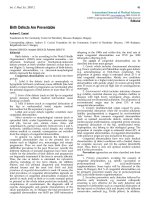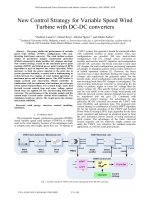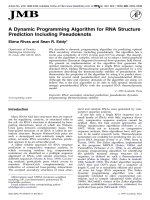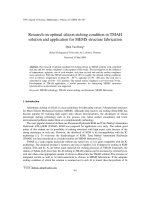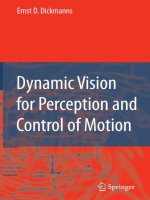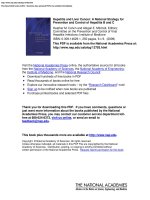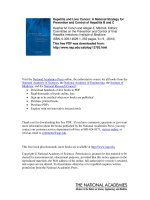Second-Order Sliding Sector for Variable Structure Control
Bạn đang xem bản rút gọn của tài liệu. Xem và tải ngay bản đầy đủ của tài liệu tại đây (924.32 KB, 22 trang )
Second-Order Sliding Sector for Variable
Structure Control
Yaodong Pan
1
and Katsuhisa Furuta
2
1
The 21st COE Century Project Office, Tokyo Denki University, Ishisaka,
Hatoyama, Hiki-gun, Saitama 350-0394, Japan
2
Department of Computers and Systems Engineering, Tokyo Denki University,
Hiki-gun, Saitama 350-0394, Japan
1 Introduction
To design a variable structure (VS) control system with sliding mode, it is neces-
sary to determine a sliding surface and a VS control law such that the reduced-
order system on the sliding surface is stable and the system converges to the
sliding surface in a finite time and stays there since then, i.e. the sliding surface
should be a stable invariant subset in the state space[4][3]. There inherently ex-
ists chattering phenomena in a VS control system with sliding mode because the
invariance can not be kept when it is implemented in a practical control system
where the switching frequency is finite.
Sliding sectors have been proposed to replace the sliding mode for a chattering
free VS controller and for the implementation of the VS controller in discrete-
time systems [6][5]. The first sliding sector proposed in [6] is a subset of the
state space where the closed-loop system is stable. The VS control law with the
sliding sector [6] ensures that the system moves into the sector in a finite time.
The robustness of the VS control system with the sliding sector was proved in
[7] by using the frequency domain criterion.
The PR-sliding sector proposed in [5] for continuous-time systems was defined
as a subset of the state space, inside which a norm of state decreases with zero
control input. The VS controller with the PR-sliding sector was designed such
that the system state moves from the outside to the inside of the sector with
a suitable VS control law, the control input is zero inside the sector, and the
norm of state keeps decreasing in the state space with specified negativity of its
derivative. The VS control system with the PR-sliding sector is quadratically
stable and robust stable to bounded parameter uncertainty [5]. The VS control
with the PR-sliding sector is called the lazy control because the VS control law is
active only outside the PR-sliding sector, which may be useful to some practical
control systems.
Theoretically the PR-sliding sector with the corresponding VS control law for
continuous-time systems is an invariant subset of the state space but with zero
G. Bartolini et al. (Eds.): Modern Sliding Mode Control Theory, LNCIS 375, pp. 97–118, 2008.
springerlink.com
c
Springer-Verlag Berlin Heidelberg 2008
98 Y. Pan and K. Furuta
control input inside the PR-sliding sector, it can not ensure that the system state
remains inside the sector forever in a real control system with finite switching
frequency. In the most of case there exists a potential possibility for the system
state to move out of the sector. The VS control law outside the PR-sliding sector
lets the system state move back into the sector as soon as it moves out of the
sector. Therefore it is necessary to switch the control input on the boundary
of the sector with infinite frequency to guarantee the invariance of the sector.
Thus the invariance may be lost because of finite switching frequency when it
is implemented in a real control system although it does not affect the stability
of the VS control system with the PR-sliding sector. It is proposed to use a
hysteresis function to design the VS control law (See Equation (20) of [5]), with
which the system may stay inside the sector longer and the invariance is obtained
to a certain extent.
As an effective method to deal with the chattering problem and to obtain
higher sliding accuracy, high-order sliding mode controllers [8][1][2][9] and high-
order sliding mode observers [10][11] have been proposed and can be implemented
in many mechanical systems[12][13]. The high-order sliding mode with s =˙s =
··· = s
(r−1)
ensure the sliding mode to be a high-order invariant subset in
the state space. Similarly, a second order sliding sector has also been proposed
[14] for continuous-time[15] and discrete-time[16] systems to attain the invariant
property. The second-order sliding sector is a PR-sliding sector and an invariant
subset of the state space. Therefore, it was named an invariant sliding sector in
[14]. Inside the invariant sliding sector, a norm of state decreases because it is a
PR-sliding sector. And especially inside the sector, the state will not move out
of the sector with a suitable control law. The VS controllers with the invariant
PR-sliding sector ensure that the system state moves from the outside to the
inside of the sector in a finite time, stays inside it forever after being moved into
it, and some Lyapunov function keeps decreasing in the state space with a VS
control law. The resultant VS control system thus is quadratically stable and
without any chattering. Such invariant sliding sector for continuous-time systems
remains invariant even if the switching frequency is finite. In [17], Yu and Yu also
discussed the existence of an invariant sliding sector for a second order discrete-
time system and gave conditions to guarantee the existence. As comparison
with those sliding sectors proposed in [6] and [5], the VS control system with
the invariant sliding sector is more realizable for practical implementations and
may result in a continuous control input.
As the objective of this paper, based on the PR-sliding sector proposed in [5],
a second-order (i.e. an invariant) PR-sliding sector for continuous-time systems
will be designed at first. Then a quadratically stable VS control system with the
sector will be proposed, where an internal and an outer sector are introduced to
let the VS control law be continuous on the system state and realizable. Finally
the proposed VS control algorithm is implemented to an inverted pendulum
control system.
This chapter is organized as follows. Section 2 presents the PR-sliding sector
[5], defines the second-order PR-sliding sector and describes the problem to be
Second-Order Sliding Sector for Variable Structure Control 99
considered in this chapter. Section 3 designs the second-order PR-sliding sector
based on a normal switch function. Section 4 proposes the VS controller with
the second-order PR-sliding sector. Section 5 gives simulation results with the
inverted pendulum.
2 Problem Description
In this chapter, a linear time-invariant continuous-time single input system with
parameter uncertainties and external disturbances, described by the following
state equation is taken into consideration.
˙x(t)=Ax(t)+B(u(t)+d(x, t)) (1)
where x(t) ∈ R
n
and u(t) ∈ R
1
are the state and the input vectors, respectively,
A and B are constant matrices of appropriate dimensions, pair (A, B) is control-
lable, and d(x, t) represents parameter uncertainties and external disturbances.
It is assumed that d(x, t) is bounded and satisfies
d
2
(x, t) ≤ w(x), ∀x ∈ R
n
, ∀t ∈ [0, +∞), (2)
where w(x)=x
T
Wxis a quadratic function function on x and W = W
T
∈ R
n×n
is a known positive definite matrix.
If the autonomous system ˙x(t)=Ax(t) of the above one in (1) is quadratically
stable, then there exists a positive definite symmetric matrix P and a positive
semi-definite symmetric matrix R = C
T
C such that
˙
L(x)=x
T
(A
T
P + PA)x ≤−x
T
Rx, ∀x ∈ R
n
(3)
where P ∈ R
n×n
, R ∈ R
n×n
, C ∈ R
l×n
, l ≥ 1, (C, A) is an observable pair, and
L(x) is a Lyapunov function candidate defined as
L(x)=||x||
2
P
= x
T
Px >0, ∀x ∈ R
n
,x=0. (4)
For an unstable system, the inequality (3) does not hold. It is possible to de-
compose the state space into two parts such that one part satisfies the condition
˙
L(x) > −x
T
Rx for some elements x ∈ R
n
, and the other part satisfies the con-
dition
˙
L(x) ≤−x
T
Rx for some other elements x ∈ R
n
. The latter elements form
a special subset in which the Lyapunov function candidate L(x) decrease with
zero control input.
We define a P-norm, denoted by ||x||
P
as the square root of the Lyapunov
function candidate L(x) in (4), i.e.
||x||
P
=
L(x)=
√
x
T
Px, x ∈ R
n
. (5)
Then the P -norm ||x||
P
decreases inside this special subset with zero control
input as
d
dt
||x||
2
P
= x
T
(A
T
P + PA)x ≤−x
T
Rx.
100 Y. Pan and K. Furuta
Accordingly, we call this special subset a PR-sliding sector because the matrices
P and R together with the system parameter A determine the property of this
subset. The definition of the PR-Sliding Sector found in [5] is given as follows.
Definition 1. The PR-Sliding Sector is defined on the state space R
n
as
S = {x| s
2
(x) ≤ δ
2
(x),x∈ R
n
}, (6)
inside which the P -norm of the system (1) decreases and satisfies
d
dt
||x||
2
P
=
d
dt
(x
T
(t)Px(t)) ≤−x
T
(t)Rx(t), ∀x(t) ∈S
where P and R are the matrices as described above, and s(x) and δ
2
(x) are a
linear and a quadratic functions, respectively.
Such PR-sliding sector is a subset of R
n
around a hyperplane s(x)=0and
is bounded by two surfaces s(x)=±
δ
2
(x). Inside the sector, the P -norm
decreases. Therefore a VS control law based on the PR-sliding sector can be
designed such that the system moves into the sector where the P -norm decreases.
Unfortunately, the PR-sliding sector is not an invariant subset in the state space
when it is implemented in a real control system with finite sampling frequency.
Similar to the definition of the second-order sliding mode control, i.e., s =˙s =0,
one more condition
d
dt
s
2
(x) ≤
d
dt
δ
2
(x)
is included to obtain the invariance of the sector besides the condition s
2
(x) ≤
δ
2
(x) used to define the sliding sector in (6).
Definition 2. The PR-sliding sector defined in (6) is said to be a Second-order
PR-Sliding Sector denoted by
S
2nd
= {x| s
2
(x) ≤ δ
2
(x),x∈ R
n
} (7)
whichiscomposedofaninternalsectorS
i
and an outer sector S
o
as
S
i
= {x| ξ
2
(x) <s
2
(x) ≤ δ
2
(x),x∈ R
n
} (8)
S
o
= {x| s
2
(x) ≤ ξ
2
(x),x∈ R
n
} (9)
if
1. The P -norm decreases inside the second-order PR-sliding sector S
2nd
with
some control input and satisfies
d
dt
||x||
2
P
=
d
dt
(x
T
(t)Px(t)) ≤−x
T
(t)Rx(t), ∀x(t) ∈S
2nd
.
Second-Order Sliding Sector for Variable Structure Control 101
2. Quadratic functions ξ
2
(x) and δ
2
(x) on x satisfy
0 <ξ
2
(x) <δ
2
(x), ∀x ∈ R
n
(10)
where
ξ
2
(x)=x
T
Ξx, (Ξ = Ξ
T
> 0,Ξ ∈ R
n×n
), (11)
δ
2
(x)=x
T
Δx, (Δ = Δ
T
> 0,Δ∈ R
n×n
). (12)
3. And the following inequality holds inside the outer sector S
o
.
d
dt
s
2
(x) ≤
d
dt
δ
2
2
(x), ∀x(t) ∈S
o
. (13)
The internal sector S
i
and the outer sector S
o
given above satisfy
S
i
S
o
= S
2nd
, S
i
S
o
= N
where N is the null set in R
n
. The second-order PR-sliding sector defined above
is an invariant subset with the P -norm decreasing inside it because for any
system state inside the outer sector, the system will remain inside the outer
sector or move into the internal sector, i.e. stay inside the second-order sliding
sector, and for any state inside the internal sector, the system may move to the
outer sector but will never move out of the sliding sector. Therefore for some time
moment, if the system moves into the second-order sliding sector, the system will
stay inside the sector since then. The last condition
d
dt
s
2
(x) ≤
d
dt
δ
2
(x)inthe
above definition shows the invariant property of a second-order sliding sector.
By decomposing the sector to an internal and an outer sectors, a large control
input to ensure the second-order property inside the outer sector can be avoided
while the invariance of the sector can be guaranteed.
It has been pointed out in [5] that the PR-sliding sector exists with some
P and R for any controllable systems and can be designed by using the Riccati
equation. In this chapter, the PR-sliding sector and the second-order PR-sliding
sector will be designed based on a normal switch function, which is used to realize
a VS control system with sliding mode. The control objective with the second-
order PR-sliding sector is to let the system move into the sector in a finite time
and remain inside the sector since then with some suitable control rule and to
stabilize the system quadratically.
3 Second-Order Sliding Sector
3.1 Design of Switch Function
A switching function defined as
s(x)=Sx(t),S∈ R
1×n
(14)
should be designed such that the reduced order system on the sliding mode:
102 Y. Pan and K. Furuta
˙x(t)=Ax(t)+B (u(t)+d(x, t))
s(x)=Sx(t)=0
(15)
is stable. Since it is assumed that the pair (A, B) is controllable, there exists a
nonsingular matrix F
1
∈ R
n×n
that converts the plant of Eq.(1) to the control-
lable canonical form:
˙
¯x(t)=
¯
A¯x(t)+
¯
B(u(t)+d(x, t)) (16)
which can be rewritten as the block form:
d
dt
¯x
1
(t)
¯x
2
(t)
=
¯
A
11
¯
A
12
¯
A
21
¯
A
22
¯x
1
(t)
¯x
2
(t)
+
¯
B
1
¯
B
2
(u(t)+d(x, t)), (17)
where ¯x
1
(t) ∈ R
n−1
,¯x
2
(t) ∈ R
1
,and
¯
A = F
−1
1
AF
1
=
¯
A
11
¯
A
12
¯
A
21
¯
A
22
=
⎡
⎢
⎢
⎢
⎢
⎢
⎣
01
0
.
.
.
.
.
.
.
.
.
01
0
00··· 0
1
−a
0
−a
1
··· −a
n−2
−a
n−1
⎤
⎥
⎥
⎥
⎥
⎥
⎦
¯
B = F
−1
1
B =
¯
B
1
¯
B
2
=
⎡
⎢
⎢
⎢
⎣
0
.
.
.
0
1
⎤
⎥
⎥
⎥
⎦
.
Then the switching function given by Eq.(14) can be rewritten as
s(x)=Sx(t)=
¯
S¯x(t)=
¯
S
1
¯x
1
(t)+
¯
S
2
¯x
2
(t), (18)
where
¯
S := SF
1
=: [
¯
S
1
¯
S
2
],
¯
S
1
∈ R
1×(n−1)
and
¯
S
2
∈ R
1
. Without loss of
generality, it is assumed that
¯
S
2
=1.
An equivalent control input guaranteeing ˙s(x)=0isgivenby
u
eq
(t)=−(SB)
−1
SAx(t)=−SAx(t), (SB =
¯
S
¯
B =1). (19)
With the control input
u(t)=u
eq
(t)+v(t), (20)
the system in Eq.(16) can be written as
˙
¯x(t)=
¯
A
eq
¯x(t)+
¯
B(v(t)+d(x, t)) (21)
where the matrix
¯
A
eq
is determined by
¯
A
eq
=
¯
A
11
¯
A
12
−
¯
S
1
¯
A
11
−
¯
S
1
¯
A
12
Second-Order Sliding Sector for Variable Structure Control 103
and v(t) is an alternative control input. Taking a nonsingular transformation
˜x(t)=F
2
¯x(t) (22)
with
F
2
=
I
n−1
O
(n−1)×1
¯
S
1
1
,
the system in Eq.(17) with the control input given by Eq.(20) is transformed
into
˙
˜x(t)=
˜
A
eq
˜x(t)+
˜
B(v(t)+d(x, t)) (23)
where the state variable ˜x(t) and the system matrices
˜
A
eq
and
˜
B can be written
as the following block forms:
˜x(t)=
˜x
1
(t)
˜x
2
(t)
= F
2
¯x(t)=
¯x
1
(t)
s(x)
,
˜
A
eq
=
˜
A
11
˜
A
12
˜
A
21
˜
A
22
= F
2
¯
A
−1
eq
F
2
=
¯
A
11
−
¯
A
12
¯
S
1
¯
A
12
O
1×(n−1)
0
,
˜
B =
˜
B
1
˜
B
2
= F
2
¯
B =
O
(n−1)×1
1
=
¯
B,
I
n−1
is the identity matrix of order (n − 1), O
(n−1)×1
and O
1×(n−1)
are the
zero (n −1)-column and row vectors, respectively.
It follows from Eq.(23) that
˙
¯x
1
(t)=(
¯
A
11
−
¯
A
12
¯
S
1
)¯x
1
(t)+
¯
A
12
s(x) (24)
˙s(x)=v(t)+d(x, t). (25)
Accordingly, the reduced order system of Eq.(15) on the sliding mode s(x)=0
becomes
˙
¯x
1
(t)=(
¯
A
11
−
¯
A
12
¯
S
1
)¯x
1
(t). (26)
It is obvious that the pair (
¯
A
11
,
¯
A
12
) is controllable. Therefore it is easy to
design a feedback gain
¯
S
1
such that the above reduced order system with
˜
A
11
=
¯
A
11
−
¯
A
12
¯
S
1
is stable, for example, by using the pole assignment algorithm or
the LQR control method[18][19]. In this way, a switch function
s(x)=Sx(t)=[
¯
S
1
1]F
−1
1
x(t) (27)
can be designed.
3.2 Design of Sliding Sector
With the switch function designed in the last subsection, a PR-sliding sector
defined in Eq.(6) can be designed by choosing the switching function s(x)in
104 Y. Pan and K. Furuta
Eq.(27) as the linear function s(x) in Eq.(6). In this case, the problem is how
to determine the matrices P and R and also the control law to satisfy those
conditions for a PR-sliding sector.
As the switch function is designed so that the reduced order system in Eq.(26)
is stable, there exists a positive definite symmetric matrix
˜
P
11
∈ R
(n−1)×(n−1)
such that the following Lyapunov equation holds for some positive definite sym-
metric matrix
˜
Q
11
∈ R
(n−1)×(n−1)
.
−
˜
Q
11
=
˜
A
T
11
˜
P
11
+
˜
P
11
˜
A
11
(28)
Choose positive definite symmetric matrices
˜
P and
˜
R as
˜
P =
˜
P
11
0
(n−1)×1
0
1×(n−1)
h
2
∈ R
n×n
(29)
˜
R =
˜
Q
11
−
˜
P
11
¯
A
12
−
¯
A
T
12
˜
P
11
h
∈ R
n×n
, (30)
where h is a large enough positive constant such that the matrix
¯
R is positive
definite. Then a PR-sliding sector can be designed as
S = {x | s
2
(x) ≤ δ
2
(x, t),x∈ R
n
} (31)
with the linear function s(x) being the switching function given in Eq.(27), the
quadratic function δ
2
(x)as
δ
2
(x)=x
T
Δx, (32)
and the positive definite symmetric matrices P and R determined by
P =(F
−1
1
)
T
F
T
2
˜
PF
2
F
−1
1
(33)
R =(F
−1
1
)
T
F
T
2
˜
RF
2
F
−1
1
, (34)
where
˜
P and
˜
R are given by Eqs.(29) and (30), respectively, F
1
and F
2
are
transformation matrices defined in the last subsection, and Δ is chosen to be
Δ = βP (35)
with some positive constant β and γ satisfying
βP ≥ γW. (36)
For the Lyapunov function candidate
L(x)=x
T
(t)Px(t)=˜x
T
(t)
˜
P ˜x(t),
the following holds with above definitions.
Second-Order Sliding Sector for Variable Structure Control 105
˙
L(x)=˜x
T
(t)(
˜
A
T
eq
˜
P +
˜
P
˜
A
eq
)˜x(t)+2˜x
T
(t)
˜
P
˜
B(v(t)+d(x, t))
=˜x
T
(t)(
˜
A
T
11
O
(n−1)×1
˜
A
T
12
0
˜
P
11
0
(n−1)×1
0
1×(n−1)
h
2
+
˜
P
11
0
(n−1)×1
0
1×(n−1)
h
2
˜
A
11
˜
A
12
O
1×(n−1)
0
)˜x(t)
+2
¯x
1
(t)
s(x)
T
˜
P
11
0
(n−1)×1
0
1×(n−1)
h
2
O
(n−1)×1
1
(v(t)+d(x, t))
=˜x
T
(t)
˜
A
T
11
˜
P
11
+
˜
P
11
˜
A
11
˜
P
11
˜
A
12
˜
A
T
12
˜
P
11
0
˜x(t)+hs(x)(v(t)+d(x, t))
=
¯x
1
(t)
s(x)
T
−
˜
Q
11
˜
P
11
˜
A
12
˜
A
T
12
˜
P
11
−h
¯x
1
(t)
s(x)
+ hs
2
(x)+hs(x)(v(t)+d(x, t))
= −˜x
T
(t)
˜
R˜x(t)+hs(x)(s(x)+v(t)+d(x, t))
= −x
T
(t)Rx(t)+hs(x)(s(x)+v(t)+d(x, t))
Therefore inside the PR-sliding sector(i.e., s
2
(x) ≤ δ
2
(x)), if the control law
is given by
u(t)=u
eq
+ v(t)=u
eq
− kδ(x) ·sgn (s(x)) , (37)
where δ(x)=
δ
2
(x) ,the equivalent control input u
eq
is given in Eq.(19) and
k (k>1+1/
√
γ) is a large enough positive constant parameter, then we have
˙
L(x)=−x
T
(t)Rx(t)+hs(x)(s(x)+v(t)+d(x, t))
= −x
T
(t)Rx(t)+hs(x)(s(x) − kδ(x) · sgn (s(x)) + d(x, t))
≤−x
T
(t)Rx(t)+|s(x)|(δ(x) −kδ(x)+|d(x, t)|)
≤−x
T
(t)Rx(t)+|s(x)|(−
1
√
γ
δ(x)+
√
x
T
Wx)
= −x
T
(t)Rx(t)+|s(x)|(−
√
β
√
γ
√
x
T
Px+
√
x
T
Wx)
≤−x
T
(t)Rx(t).
The following theorem concludes the above discussion.
Theorem 1. The subset designed in Eq.(31) is a PR-sliding sector with corre-
sponding parameters discussed above, inside which the P -norm decreases with
the control law given by Eq.(37) as
d
dt
L(x)=
d
dt
||x||
2
P
=
d
dt
(x
T
(t)Px(t)) ≤−x
T
(t)Rx(t).
3.3 Second-Order Sliding Sector
Based on the PR-sliding sector designed in the last subsection, an internal and
an outer sectors for the second-order PR-sliding sector are designed as
106 Y. Pan and K. Furuta
S
o
= {x| αδ
2
(x) <s
2
(x) ≤ δ
2
(x),x∈ R
n
}, (38)
S
i
= {x| s
2
(x) ≤ αδ
2
(x),x∈ R
n
} (39)
where α is a positive constant satisfying 0 <α<1andαδ
2
(x) is chosen to be the
quadraticfunction ξ
2
(x) used in Definition 2 of thesecond-orderPR-slidingsector.
Theorem 2. The PR-sliding sector designed in the last subsection with Δ = βP
and the internal and outer sectors determined above is a second-order PR-sliding
sector as
S
2nd
= {x| s
2
(x) ≤ δ
2
(x),x∈ R
n
} (40)
with the VS control law of
u(t)=u
eq
(t)+v(t)=u
eq
(t)+
−k
δ
2
(x)
s(x)
,x∈S
o
−k
s(x)
α
,x∈S
i
(41)
where the equivalent control input u
eq
(t) is given in Eq.(19), k is a large enough
positive constant, and parameters are chosen to satisfy the following relations:
k>1+
1
√
γ
(42)
β<
2
h
(43)
R>2h
√
α
√
γ
βP (44)
R<(hβα +(2−hβ)(k −
1
√
γ
))P. (45)
Proof. First let’s consider the internal sector. In this case s
2
(x) ≤ αδ
2
(x)and
the control law is given by
u(t)=u
eq
(t)+v(t),v(t)=−k
s(x)
α
.
Thus the derivative of the Lyapunov function candidate L(x) defined by (4) is
d
dt
L(x)==
d
dt
||x||
2
P
= −x
T
(t)Rx(t)+hs(x)(s(x)+v(t)+d(x, t))
= −x
T
(t)Rx(t)+hs(x)(s(x) − k
s(x)
α
+ d(x, t))
≤−x
T
(t)Rx(t)+h|s(x)|(|s(x)|−k
|s(x)|
α
)+h|s(x)||d(x, t)|
≤−x
T
(t)Rx(t)+h|s(x)|(|s(x)|−k
|s(x)|
α
)+h
√
α
√
γ
δ
2
(x))
< −x
T
(t)(R − h
√
α
√
γ
βP)x(t)
< −
1
2
x
T
(t)Rx(t),
i.e., the P -norm decreases inside the internal sector.
Second-Order Sliding Sector for Variable Structure Control 107
Now let’s consider the outer sector. In this case, αδ
2
(x) <s
2
(x) ≤ δ
2
(x)and
the control law is given by
u(t)=u
eq
(t)+v(t),v(t)=−k
δ
2
(x)
s(x)
.
Define a quadratic function V (x)as
V (x)=s
2
(x) −δ
2
(x) (46)
Then it follows inside the outer sector that
d
dt
V (x)=
d
dt
(s
2
(x) −δ
2
(x)) = 2s(x)˙s(x) − β
d
dt
L(x)
=2s(x)(v(t)+d(x, t)) −β(−x
T
(t)Rx(t)+hs(x)(s(x)+v(t)+d(x, t)))
= βx
T
(t)Rx(t) − hβs
2
(x)+(2−hβ)s(x)(v(t)+d(x, t))
= βx
T
(t)Rx(t) − hβs
2
(x)+(2−hβ)(−kδ
2
(x)+s(x)d(x, t))
≤ βx
T
(t)Rx(t) − hβαδ
2
(x)+(2−hβ)(−k +
1
√
γ
)δ
2
(x)
= βx
T
(t)Rx(t) − (hβα +(2−hβ)(k −
1
√
γ
))δ
2
(x)
= βx
T
(t)(R − (hβα +(2−hβ)(k −
1
√
γ
))P )x(t)
< 0, (47)
i.e. inside the outer sector, the following holds.
d
dt
s
2
(x) <
d
dt
δ
2
(x),
which means that the system state inside the second-order PR-sliding sector will
not move out of the sector.
At the same time, the derivative of the Lyapunov function candidate L(x)is
d
dt
L(x)=−x
T
(t)Rx(t)+hs(x)(s(x)+v(t)+d(x, t))
= −x
T
(t)Rx(t)+hs
2
(x) −hkδ
2
(x)+hs(x)d(x, t))
≤−x
T
(t)Rx(t)+hδ
2
(x) −hkδ
2
(x)+
h
√
γ
δ
2
(x)
= −x
T
(t)Rx(t)+h(1 −k +
1
√
γ
)δ
2
(x)
< −x
T
(t)Rx(t)
i.e., the P -norm decreases inside the internal sector.
Therefore the designed PR-sliding sector is a second-order one and the P -
norm decreases inside the sector.
108 Y. Pan and K. Furuta
4 VS Controller with Second-Order Sliding Sector
With the second-order PR-sliding sector designed in Theorem 2, a VS con-
troller should be designed to move the system from the outside to the inside
of the second-order PR-sliding sector in a finite time while the P-norm keeps
decreasing.
Theorem 3. With the internal sector (39), the outer sector (38), and the
second-order PR-sliding sector (40) designed in Theorem 2, the following con-
tinuous VS control law
u(t)=u
eq
(t)+v(t),v(t)=
⎧
⎪
⎨
⎪
⎩
−ks(x) x
¯
∈S
2nd
−k
δ
2
(x)
s(x)
x ∈S
o
−k
s(x)
α
x ∈S
i
(48)
ensures that
1. the state moves from the outside to the inside of the second-order PR-sliding
sector in a finite time and remains inside it since then,
2. the P -norm keeps decreasing in the state space and the resultant VS control
system is stable with
˙
L(x)=
d
dt
||x||
2
P
≤ 0, ∀x ∈ R
n
where the equivalent control input u
eq
(t) is given in Eq.(19), and α and k satisfy
the conditions given in Theorem 2.
Proof. It is obvious that the proposed VS control law u(t)(48),whichmay
be denoted as u(t):=u(x(t)) := u(x) is continuous on x inside the internal
sector, inside the outer sector, and outside the second-order sector and is also
continuous in each switching instant happening in the boundaries of the second-
order PR-sliding sector (40) and the internal sector (39) satisfying s
2
(x)=δ
2
(x)
and s
2
(x)=αδ
2
(x), respectively. Thus the VS control law (48) is continuous in
the state space and no chattering will happen.
It has been shown in the proof of Theorem 2 that the sector designed in
Theorem 2 is a second-order one. Thus the proof will be finished if it can be
shown that outside the second-order PR-sliding sector, the P -norm decreases
and the system moves into the sector in a finite time.
Outside the second-order PR-sliding sector, the following inequality holds:
s
2
(x) >δ
2
(x)
and the control input is given by
u(t)=u
eq
(x)+v(t),v(t)=−ks(x).
In this case, the derivative of the Lyapunov function candidate L(x) defined by
(4) is
Second-Order Sliding Sector for Variable Structure Control 109
d
dt
L(x)=−x
T
(t)Rx(t)+hs(x)(s(x)+v(t)+d(x, t))
= −x
T
(t)Rx(t)+hs
2
(x) −hks
2
(x)+hs(x)d(x, t))
≤−x
T
(t)Rx(t)+hs
2
(x) −hks
2
(x)+
h
√
γ
s
2
(x)
= −x
T
(t)Rx(t)+h(1 −k +
1
√
γ
)s
2
(x)
< −x
T
(t)Rx(t) < 0,
i.e., the P -norm decreases outside the invariant PR-sliding sector.
Now let’s consider the quadratic function V (x) defined in (46), then similar
to (47), it follows that
d
dt
V (x)=
d
dt
(s
2
(x) −δ
2
(x)) = 2s(x)˙s(x) − β
d
dt
L(x)
=2s(x)(v(t)+d(x, t)) −β(−x
T
(t)Rx(t)+hs(x)(s(x)+v(t)+d(x, t)))
= βx
T
(t)Rx(t) − hβs
2
(x)+(2−hβ)s(x)(v(t)+d(x, t))
= βx
T
(t)Rx(t) − hβs
2
(x)+(2−hβ)(−ks
2
(x)+s(x)d(x, t))
≤ βx
T
(t)Rx(t) − hβs
2
(x)+(2−hβ)(−k +
1
√
γ
)s
2
(x)
<βx
T
(t)Rx(t) − hβαδ
2
(x) −((2 − hβ)(k −
1
√
γ
)δ
2
(x)
= βx
T
(t)(R − (hβα +(2−hβ)(k −
1
√
γ
))P )x(t)
< 0.
which means that outside the sector-order PR-sliding sector, the quadratic func-
tion V (x) decreases, i.e., the system will move into the second-order PR-sliding
sector. Besides, from the relation of
d
dt
s
2
(x)=2s(x)(v(t)+d(x, t)) = −2ks
2
(x)+2s(x)d(x, t)
≤−2(k −
1
√
γ
)s
2
(x) < −2s
2
(x) < −2δ
2
(x) < 0,
it can be concluded that the system will move toward the sliding mode s(x)=0,
will move into the sliding sector in a finite time although it may need infinite
time to converge to the sliding mode s(x) = 0. This ends the proof.
5 Simulation Results with Furuta Pendulum
5.1 Furuta Pendulum
Because of static friction inherently existing in all mechanical systems, it is
difficult to control the position, speed and torque of a motor at the slow speed.
110 Y. Pan and K. Furuta
On the stabilization control of an inverted pendulum, it is much more difficult to
keep the pendulum strictly inverted at a predetermined motor position because
the motor has to switch the rotation direction frequently to keep the balance.
Hence it can be expected that the proposed VS control, which can take the time-
varying friction into consideration, enhances the performance of the stabilization
control for the inverted pendulum.
The apparatus is shown in Fig.1. The pendulum-link is equipped on the output
axis of a direct drive motor, and the link can rotate around the pivot freely.
Fig. 1. Furuta pendulum
5.2 Derivation of Dynamic Equation
The dynamic equation of the pendulum can be obtained by using Lagrange
method. To calculate the energies, the coordinate values of each center of grav-
ity(COG) are calculated. The coordinate systems attached according to DH-
convention method are shown in Fig.2. θ
1
,θ
2
and τ are angles of the motor and
the pendulum, and the input torque respectively. The DH-parameters are listed
in Tab.1 and the mechanical parameters and their meanings are described in
Tab.2
Second-Order Sliding Sector for Variable Structure Control 111
1
x
0
x
0
y
0
z
0
o
1
θ
2
θ
1
y
1
z
2
z
2
x
2
y
1
d
2
b
2
l
1
l
Fig. 2. Modeling of 1-link Furuta pendulum
Describing a homogeneous transformation matrix that translates j-coordinate
system to i-coordinate by “
i
A
j
”, the following matrices are obtained.
0
A
1
=
⎡
⎢
⎢
⎣
cos θ
1
0sinθ
1
0
sin θ
1
0 −cosθ
1
0
01 0 0
00 0 1
⎤
⎥
⎥
⎦
1
A
2
=
⎡
⎢
⎢
⎣
cos θ
2
−sinθ
2
0 l
2
cos θ
2
sin θ
2
cos θ
2
0 l
2
sin θ
2
001l
1
0001
⎤
⎥
⎥
⎦
.
Describing a COG of the link-2 on the coordinate-2 as p
2
:= [−b
2
, 0, 0, 0]
T
,the
coordinate value of this point on the global coordinate is computed by
112 Y. Pan and K. Furuta
Table 1. DH parameters
link a
i
d
i
α
i
θ
i
1 0 d
1
+
π
2
θ
1
2 l
2
l
1
0 θ
2
Table 2. Mechanical parameters of a Furuta pendulum
value meanings
l
1
0.913 [m] length of the link-1
J
1
1.22694 [kg ·m
2
] inertia of the link-1 around its pivot
c
1
6.02185 [Nms/rad] viscous coefficient of the link-1
l
2
0.384 [m] length of the link-2
J
2
0.04519 [kg ·m
2
] inertia of the link-2 around its COG
c
2
9.17951 ×10
−4
[Nms/rad] viscous coefficient of the link-2
b
2
0.1987 [m] distance from a tip to a COG of the link-2
m
2
0.7150 [kg] mass of the link-2
0
p
2
=
0
A
1
·
1
A
2
·
2
p
2
.
Therefore the kinematics energy K is calculated as
K =
J
1
˙
θ
2
1
2
+
J
2
˙
θ
2
2
2
+
m
2
2
d
dt
0
p
2x
2
+
d
dt
0
p
2y
2
+
d
dt
0
p
2z
2
,(49)
where
0
p
2x
means the x-component of vector
0
p
2
and the others are similar.
The potential energy U is determined by
U = m
2
g
0
p
2z
. (50)
Considering viscous of the joints, a dissipative term is given by
R =
1
2
c
1
˙
θ
2
1
+
1
2
c
2
˙
θ
2
2
. (51)
Setting Lagrangian L = K−U, substituting Eqs.(49),(50) and (51) into the
Lagrange equation:
d
dt
∂L
∂
˙
θ
i
−
∂L
∂θ
i
+
∂R
∂
˙
θ
i
= τ
i
, (52)
replacing θ
2
as θ
2
→ θ
2
+π/2tocorrespondθ
2
= 0 to the upper equilibrium, and
rewriting as l
b
:= l
2
−b
2
for convenience yield the following dynamic equations.
p
11
¨
θ
1
+ p
12
¨
θ
2
+ q
1
= τ
p
12
¨
θ
1
+ p
22
¨
θ
2
+ q
2
=0.
(53)
Second-Order Sliding Sector for Variable Structure Control 113
p
11
:= J
1
+ m
2
l
2
+
1
2
m
2
l
2
b
(1 −cos2θ
2
)
p
12
:= −m
2
l
1
l
b
cos θ
2
p
22
:= J
2
+ m
2
l
2
b
q
1
:= c
1
˙
θ
1
+ m
2
l
b
(l
b
sin 2θ
2
˙
θ
1
˙
θ
2
+ l
1
sin θ
2
˙
θ
2
2
)
q
2
:= c
2
˙
θ
2
− m
2
l
b
1
2
l
b
sin 2θ
2
˙
θ
2
1
+ g sin θ
2
.
Linearization of the nonlinear dynamic equations in Eq.(53) around the unstable
equilibrium (θ
i
=0,
˙
θ
i
=0; i =1, 2) gives the following first order differential
equation.
E ˙x = Fx+ Gu (54)
where
x :=
θ
1
θ
2
˙
θ
1
˙
θ
2
T
E :=
⎡
⎢
⎢
⎣
10 0 0
01 0 0
00J
1
+ m
2
l
2
1
−m
2
l
1
l
b
00 −m
2
l
1
l
b
J
2
+ m
2
l
2
b
⎤
⎥
⎥
⎦
F :=
⎡
⎢
⎢
⎣
00 10
00 01
00−c
1
0
0 m
2
l
b
g 0 −c
2
⎤
⎥
⎥
⎦
G :=
0010
T
.
Substituting parameters given in Tab.2 into Eq.(54) yields the following state-
space model.
˙x = Ax + Bu (55)
A =
⎡
⎢
⎢
⎣
00 1 0
00 0 1
01.3972 −3.7331 −9.8695 × 10
−4
021.0514 −6.4745 −1.4870 × 10
−2
⎤
⎥
⎥
⎦
B =
000.6199 1.0752
T
.
The eigenvalues are { 4.4592, 0, −5.2191, −2.9880 }.
5.3 VS Controller Design for Furuta Pendulum
The switching function is designed by choosing the eigenvalues of the reduced
order system from ones of closed loop system designed by the LQ optimal
114 Y. Pan and K. Furuta
regulation. When weighting matrices are chosen as Q = diag{10, 1000, 1, 100},
R =[0.01] for the quadratic performance index J =
∞
0
(x
T
(t)Qx(t)+Ru
2
(t))dt,
the feedback gain G =[−31.6228, 513.456, −61.1981, 136.5171 ] is obtained
and the resultant eigenvalues of the closed-loop system are
{−107.91, −3.16, −0.76 ±0.70i }. (56)
NowwechoosethematrixS of a switching function in Eq.(14) so that the
reduced order system described by Eq.(26) has the last three eigenvalues of
(56), i.e., p
1
,p
2
,p
3
= −3.16, −0.76 + 0.70i, −0.76 − 0.70i4¿ Thus a polynomial
having p
1
∼ p
3
as roots is expanded as follows.
(s +3.16)((s +0.76)
2
+0.70
2
)=s
3
+4.6806s
2
+5.8710s +3.3842
S is computed by using these coefficients of the above polynomial and the con-
trollable canonical form transform matrix F
1
.
S =[3.3842, 5.8710, 4.6806, 1]· F
−1
1
=[−0.2931, 4.5262, 0.5086, 1.2233], (57)
where
F
1
=[B,AB,A
2
B,A
3
B ]
⎡
⎢
⎢
⎣
a
2
a
3
a
4
1
a
3
a
4
1
a
4
1
1
⎤
⎥
⎥
⎦
=
⎡
⎢
⎢
⎣
−11.5480 0.0082 0.6199 0
0.0000 −0.0000 1.0752 0
−0.0000 −11.5480 0.0082 0.6199
−0.0000 0.0000 −0.0000 1.0752
⎤
⎥
⎥
⎦
|sI −A| = s
4
+ a
4
s
3
+ a
3
s
2
+ a
2
s + a
1
= s
4
+3.7480s
3
− 21.0023s
2
− 69.5406s.
By choosing
˜
Q
11
= I(3) and h =3.5, the positive definite matrix P for
the definition of the Lyapunov function candidate and the sliding sectors is
obtained as
P =
⎡
⎢
⎢
⎣
0.1653 −2.2553 0.2571 −0.6252
−2.2553 36.9835 −3.9862 9.6654
0.2571 −3.9862 0.4596 −1.0929
−0.6252 9.6654 −1.0929 2.6213
⎤
⎥
⎥
⎦
.
In the simulation, the sampling interval is chosen as τ =0.001second and
other parameters are chosen to be
β =0.1,α=0.2,k= 100.0.
The simulation result with the proposed VS controller is shown in Figures
3 – 6. The inverted pendulum can be stabilized at its up position without any
Second-Order Sliding Sector for Variable Structure Control 115
Fig. 3. Motor Angle with 2nd-order Sliding Sector Control
Fig. 4. Pendulum Angle with 2nd-order Sliding Sector Control
Fig. 5. Control Input with 2nd-order Sliding Sector Control
116 Y. Pan and K. Furuta
Fig. 6. Movement among Sectors with 2nd-order Sliding Sector Control
Fig. 7. Motor Angle with Sliding Mode Control
Fig. 8. Pendulum Angle with Sliding Mode Control
Second-Order Sliding Sector for Variable Structure Control 117
Fig. 9. Control Input with Sliding Mode Control
chattering. The control input is continuous. Figure 6 shows that the system is in
the outside of the second-order PR-sliding sector in the beginning, moves into
the outer sector and then the internal sector, and stays inside the internal sector
since being moved inside it.
Figures 7–9 show the simulation result with the normal VS control law
u(t)=−ksgn(s),k= 100.0
and with the same matrix S given in Eq.(57) for the switching function s(x).
Chattering happens in this case as shown in Figure 9.
6Conclusion
The chapter designed a VS control system with the second-order PR-sliding
sector, which ensures that the system moves into the sector in a finite time and
stays inside it since then while the P -norm of state keeps decreasing in the state
space. The resultant VS control system is quadratically stable and chattering-
free with a continuous VS control law. The simulation results with an inverted
pendulum show the invariance of the proposed sector and the robustness stability
of the proposed VS control system with the second-order PR-sliding sector.
References
1. Bartolini, G., Ferrara, A., Pisano, A., Usai, E.: On the convergence properties of
a 2-sliding control algorithm for nonlinear uncertain systems. Int. J. Contr. 74,
718–731 (2001)
2. Boiko, I., Fridman, L., Castellanos, M.I.: Analysis of Second Order Sliding Mode
Algorithms in the Frequency Domain. IEEE Trans. Aut. Contr. 49, 946–950 (2004)
3. Edwards, C., Spurgeon, S.K.: Sliding Mode Control. Taylor and Francis, London
(1998)
118 Y. Pan and K. Furuta
4. Utkin, V.I.: Sliding modes in control and optimization. Springer, Berlin (1992)
5. Furuta, K., Pan, Y.: Sliding Sectors for VS Controller. Automatica 36, 211–228
(1999)
6. Furuta, K.: Sliding mode control of a discrete system. System & Control Letters 14,
145–152 (1990)
7. Furuta, K., Pan, Y.: VSS Controller Design for Discrete-time Systems. Control
Theory and Advanced Technology 10, 669–687 (1994)
8. Levant, A.: Sliding order and sliding accuracy in sliding mode control. Int. J.
Contr. 66, 1247–1263 (1993)
9. Levant, A.: Principles of 2-sliding mode design. Automatica 43, 576–586 (2007)
10. Fridman, L., Levant, A., Davila, J.: High-Order Sliding-Mode Observer for Linear
Systems with Unknown Inputs. In: Proc. 2006 IEEE Int. Workshop on Variable
Structure Systems VSS 2006, pp. 202–207 (2006)
11. Davila, J., Fridman, L., Levant, A.: Second-order sliding-mode observer for me-
chanical systems. IEEE Trans. Aut. Contr. 50, 1785–1789 (2005)
12. Bartolini, G., Pisano, A., Punt, E., Usai, E.: A survey of applications of second
order sliding mode control to mechanical systems. Int. J. Contr. 76, 875–892 (2003)
13. Damiano, A., Gatto, G.L., Marongiu, I., Pisano, A.: Second-order sliding-mode
control of DC drives. IEEE Trans. Ind. El. 51, 364–373 (2004)
14. Suzuki, S., Pan, Y., Furuta, K., Hatakeyama, S.: Invariant Sliding Sector for Vari-
able Structure Control. Asian Journal of Control 7, 124–134 (2005)
15. Pan, Y., Furuta, K., Hatakeyama, S.: Invariant Sliding Sector for Variable Struc-
ture Control. In: Proc. 38th IEEE CDC, CDC 1999, Phoenix, US, pp. 5152–5157
(1999)
16. Furuta, K., Pan, Y.: Discrete-time Variable Structure Control. In: Yu, Xu (eds.)
Variable Structure Systems: Towards the 21st Century. Lecture Notes in Control
and Information Science, vol. 274, Springer, Berlin (2001)
17. Yu, X., Yu, S.: Discrete Sliding Mode control Design with Invariant Sliding Sectors.
ASME J. Dyn. Syst. Measur. Contr. 122, 776–782 (2000)
18. Utkin, V.I., Young, K.K.D.: Methods for Constructing Discontinuity Planes in
Multidimensional Variable Structure Systems. Automation and Remote Control 39,
1466–1470 (1979)
19. Young, K.K.D., Ozguner, U.: Sliding-mode Design for Robust Linear Optimal Con-
trol. Automatica 33, 1313–1323 (1997)
